Identify how a credit card works and the advantages of revolving credits.
With different payment methods, credit cards turn out to be a great solution to finance day-to-day purchases and make your life easier. However, before obtaining one, it is vital that you are informed of the fundamental aspects of how a credit card works and that you know what revolving credit means. Only then can you manage your finances according to your needs and avoid creating economic problems.
How does a credit card work?
The first thing you should know is that accredited financial institutions issue credit cards. As a cardholder, you can buy a variety of products and services in the thousands of establishments that accept this form of payment without the need for cash.
To acquire the goods you want, it is only a matter of presenting your credit card at the store. It is accepted, and you sign a voucher to authorize your operation. Basically, in this process, the bank lends you the total amount of your purchase, which it is paying to the business to settle your debt with the banking institution.
So how do you know how much money your bank can lend you? Good. This entire procedure is possible because it grants you a credit line, that is, a limited loan amount that will depend mainly on your income level, your payment capacity, and credit history. Of course, this line can be increased little by little if you pay on time and responsibly.
It is worth mentioning that you cannot exceed the credit limit that you have available, and in this case, credit cards are distinguished by their evolvability.
What does revolving refer to?
It is a credit that you can use repeatedly and directly related to your line of credit. This means that when you pay with your card, each of your expenses will be deducted immediately from your line. But as you pay your debt, whether, in installments, that loan amount is automatically rereleased for you to use.
In itself, it is a cycle where you obtain a loan, pay it off, and have that same loan again. As simple as that.
What should you take into account?
One of the aspects that you should not omit is that since it is a loan, you will have to pay it in one way or another. So through your card, you have the possibility of deferring your payments in monthly installments or making a single total payment. However, interest or commissions can be incorporated in the case of choosing the monthly installment scheme, especially if one month you stop paying, which will cause you to increase the initial debt.
For this reason, it is better that you consider the possibility of paying off your debt in a single payment or take advantage of the promotions of interest-free months where your payment will be deferred to the months you choose without worrying about generating these surcharges.
Likewise, contemplate that you will receive your Account Statement monthly with the details of your purchases, interest, commissions, payments made, and even cash availability with your credit card. Therefore, we mention some terms that are important to know:
- Cutoff date. It is the day that the bank determines to summarize your credit movements. If the cutoff date appears on the Account Statement on the 9th of each month, then your monthly operations will be calculated from the 10th to the 9th. So any other amount that is made after the cutoff date court will be reflected in the following Account Statement.
- Minimum payment. It is the minimum amount you can pay to date on your credit. In general, a certain percentage varies between 5 to 10 percent of your total debt.
- Balance cutting. It refers to the amount owed that you have until the cutoff date.
- CAT (Total Annual Cost). Any cost you will have to pay for using your credit card. For example, interest, commissions, or annual fees.
Considering how a credit card works, you will be able to adjust and manage your purchases for the good of your finances.


